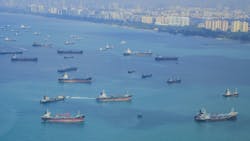Bringing High-Tech to the Maritime Industry Improves Safety and the Bottom Line
Thousands of ships and container vessels ply the oceans every day, traveling through the world’s most remote regions and delivering goods to ports all over the globe. They carry 90% of the world’s trade, as well as hundreds of crewmen, so their safe passage is paramount.
But in spite of its global importance, last year the shipping industry lost 18 cargo ships and there were also 2,703 incidents, according to a report from Allianz. (Incidents include groundings, fires, collisions, cargo losses, machine damage and other unpredictable accidents.)
One contributing factor to these accidents is the fact that the maritime industry lags behind the aviation and other transport sectors in its use of advanced technology; there are also connectivity issues that limit the effective use of devices commonly employed on land and in the air. Despite being one of the most valuable forms of transport for trade, the shipping industry is decades behind other forms of transportation.
For example, it only recently adopted Very Small Aperture Terminals (VSAT, a two-way ground station that transmits and receives narrow and broadband data from anywhere on the globe via satellites). But it’s a far cry technologically from the communication networks enjoyed by cars and aircraft.
Even today, navigators and crews rely on binoculars to spot dangerous objects and other vessels while sailing, as well as radar and other nautical instruments, with decisions made on the fly. This huge reliance on the crew to have eyes on every area around the ship places an extra burden on a them as they are already dealing with constant pressures in difficult circumstances.
Crew fatigue is already blamed as a contributing factor in up to 96% of marine incidents, and the recent global pandemic has only exacerbated this fatigue. According to that Allianz report, as of March 2021, more than 200,000 sailors were stuck onboard commercial vessels unable to return to their home ports despite it being past their contract dates. And there was a similar number of sailors who needed to board those ships to relieve the crews. This can lead to serious problems.
In July 2020, for example, the ship Wakashio ran aground off the coast of Mauritius, spilling hundreds of tons of oil. An investigation into the incident revealed that 10% of the Wakashio crew had been on board for more than 12 months, unable to disembark because of quarantine restrictions. It’s assumed that crew fatigue contributed to the two-hour delay it took the crew to realize they had been off course.
As the industry is coming to terms with the pandemic’s long-term repercussions, it has become clear that steps need to be taken to increase connectivity between ships. By opening communications between the vessel and those on shore, many of these incidents can be prevented while providing crews with the much-needed reprieve and support their counterparts in the aviation sector rely on.
The advantages go beyond the industry. Improved operations and efficiency will reduce the number of environmental incidents, such as oil spills and containers falling into the waterways, and curb the pollution caused by the maritime industry.
The adoption of VSAT technology has been a huge step forward for the industry, opening communication channels. Now that VSAT is in place, artificial intelligence can help maintain this momentum by providing insights into handling low visibility, extreme weather and crowded ports.
By tapping into a ship’s existing sensors and adding some thermal cameras, an AI-powered algorithm can turn the ship itself into a sensor, using machine learning to analyze and detect obstacles in real time for ship captains and those on shore.
This can positively disrupt the shipping industry’s entire infrastructure, from accurate navigational charts via the cloud, updating stakeholders from the command center and even tracking fuel consumption. Real-time video also helps train inexperienced navigation officers for high-risk situations. Smart alarms also have a part to play, sending life-saving alerts when grounding in shallow water and other threats arise.
With crew fatigue at an all-time high and larger vessel sailing the waters, clear communications and data sharing between ships and shore becomes a necessity. The pandemic has pushed the industry to take life-saving steps in adopting technology. Now, with autonomous cargo ships on the horizon, it is important the drive to adopt new technologies continue.
Yarden Gross is co-founder and CEO of Orca AI, a company that manufactures marine collision-avoidance systems.
About the Author
Yarden Gross
Co-founder and CEO, Orca AI
Yarden Gross is co-founder and CEO of Orca AI, a company that manufactures marine collision-avoidance systems.
